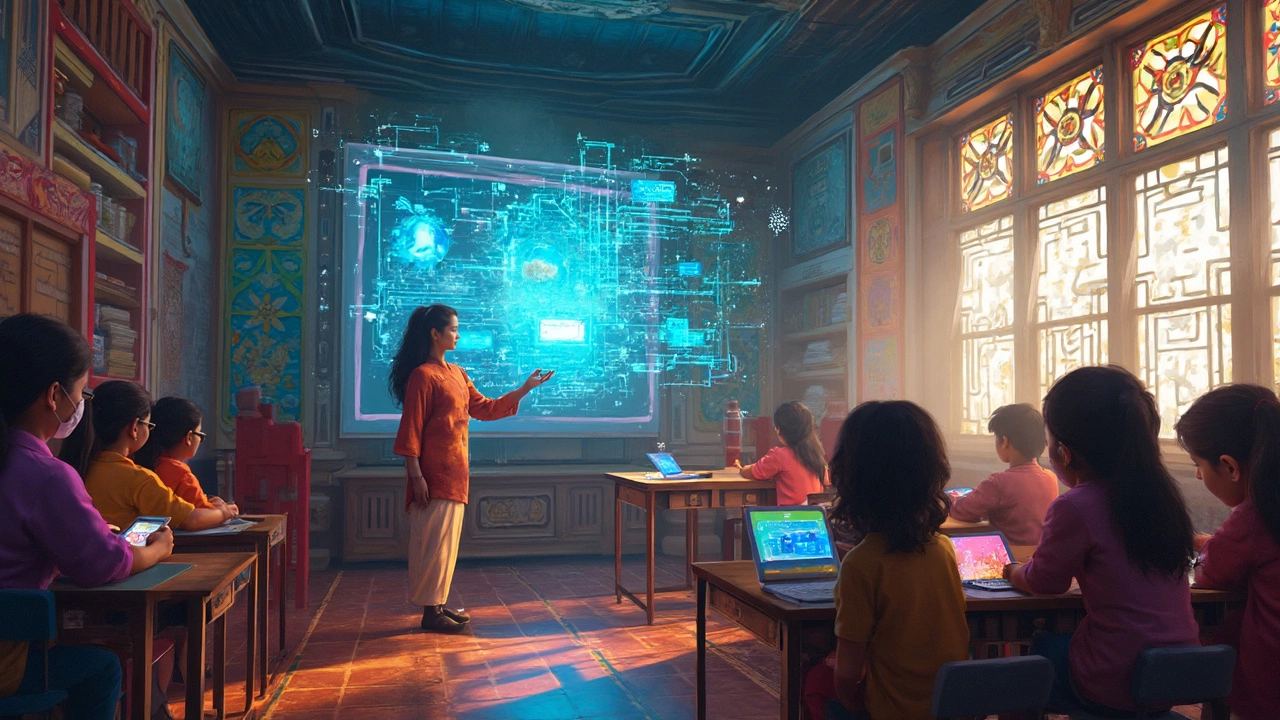eLearning has become a significant part of how individuals access education in the modern world. It's an umbrella term that includes a wide range of learning experiences delivered via digital platforms. From formal educational programs to ongoing workplace training and personal skill development, eLearning platforms have expanded the possibilities for learners and educators alike.
In an era where information and resources can be accessed with just a click, understanding the nuances of eLearning can help individuals tailor their educational experiences to better fit their lifestyles and learning goals. It isn't just about convenience; it's about exploring new ways to absorb knowledge and skills in an increasingly digital age.
- Defining eLearning
- The Evolution of Online Education
- Types of eLearning Platforms
- Benefits of Digital Education
- Challenges and Solutions in eLearning
- Future Trends and Innovations
Defining eLearning
Understanding eLearning requires diving into the multifaceted world of digital education. At its core, eLearning refers to any learning experience facilitated through electronic technologies, primarily via the Internet. This concept has rapidly evolved from simple digital courses to expansive platforms offering diverse content and interactive learning methodologies. It's not just about shifting traditional lectures to a virtual format; it's about creating an interactive, adaptive, and accessible learning ecosystem that can be personalized according to individual needs and preferences.
The rapid technological advancements have expanded the boundaries of what online learning can achieve. With increased bandwidth and improved educational technology tools, students can now experience immersive learning environments that simulate real-world scenarios, often with the help of Virtual Reality (VR) and Augmented Reality (AR). These innovations cater not only to academic curriculum but also extend to professional development and personal growth, making eLearning applicable to learners of all ages and interests. A 2023 report by the Global eLearning Industry Outlook stated, "The global eLearning market is projected to reach $500 billion by 2030, signaling a profound shift in how education is delivered and consumed."
Online learning platforms come in various shapes and sizes. Whether it is structured platforms like Coursera, offering university-level courses, or skill-specific forums such as Skillshare, aimed at art and design enthusiasts, each platform provides a unique educational angle. These platforms aren't just repositories of information; they integrate quizzes, interactive modules, and peer interaction to create an engaging educational journey. This dynamic environment encourages learners to assimilate knowledge at their own pace, making education more democratic and accessible.
Different Modes of eLearning
The diversity within eLearning can be categorized into synchronous and asynchronous learning styles. Synchronous eLearning models, such as live classes and webinars, mimic traditional classroom settings with real-time interactions between students and instructors. They foster immediate communication, allowing for direct feedback and discussions. Asynchronous eLearning, on the other hand, provides more flexibility. Learners access materials such as pre-recorded lectures, forums, and digital assessments on their schedules, promoting a self-paced learning approach that respects individual time constraints.
Statistics highlight an interesting trend – approximately 75% of higher education institutions in the U.S. are now offering online courses. This shift isn't limited to academia alone. Corporations are increasingly embracing eLearning for employee training because it is cost-effective and provides a consistent in-house skill development process. The option to learn 'anytime, anywhere' is crucial in today’s fast-paced world, reflecting a significant evolution in education delivery methods.
The Evolution of Online Education
The journey of online learning is a fascinating story of technological progress and educational reform. It all started in the early days of the internet, when the concept was merely to supplement traditional instruction. In the late 1990s, the launch of platforms like Blackboard marked a significant stride, making it possible for educators to distribute materials digitally and engage with learners over the web. Such initiatives laid the groundwork for the explosion of virtual learning environments that followed. As the new millennium progressed, broadband internet made streaming video content feasible, leading to the incorporation of multimedia into learning platforms. This was a major breakthrough, allowing interactive content like videos, animations, and simulations to become a core part of the eLearning landscape.
During the 2000s, open-source learning management systems such as Moodle gave educational institutions more customization options, further transforming how people accessed educational content. These platforms broke down barriers by making educational resources more accessible, regardless of students' geographical locations. The introduction of massive open online courses (MOOCs) in the mid-2010s marked another pivotal point. With providers like Coursera and EdX, digital education became democratized, offering high-quality courses from esteemed institutions to a global audience at little to no cost. This accessibility has been crucial in reaching millions who otherwise might have had no access to higher education opportunities.
The evolution didn’t stop there. The onset of mobile access to education spurred another wave of innovation. Nowadays, learning can happen anywhere at any time, thanks to smartphones and tablets. Many platforms have embraced this shift, ensuring their content is mobile-friendly. The COVID-19 pandemic further accelerated the adoption of online education. As schools closed worldwide, institutions rapidly transitioned to fully online delivery, highlighting both the potential and the gaps in current eLearning infrastructure. Digital education technologies were thrust into the spotlight, fueling an unprecedented increase in both development and user adoption. The need for engaging, interactive content was never more pronounced.
Currently, with advancements in artificial intelligence and machine learning, personalized learning experiences are becoming commonplace. Systems that can adapt to a student's pace and style of learning are transforming traditional educational methods. This allows education to be more tailored and effective than ever before. As digital education continues to evolve, the integration of virtual reality and augmented reality is already paving the way for immersive learning experiences. Imagine a history lesson where students can virtually walk through ancient ruins. These technologies have the potential to transform eLearning platforms into powerful tools for genuine understanding and retention.
The success of online education relies heavily on embracing change and innovation, making it an exciting field to watch. A report from Class Central noted that enrollments in MOOCs soared to 110 million in 2021, a testament to the widespread acceptance and demand of online education. Innovations continue to emphasize accessibility, interaction, and personalization, ensuring that eLearning remains at the forefront of the educational landscape. As educational needs and technology continue to evolve rapidly, it’s clear that the future will bring even more dynamic changes to how we approach learning.

Types of eLearning Platforms
The landscape of eLearning is diverse and constantly growing, encompassing various forms and platforms designed to meet different educational needs. First, we see the emergence of Massive Open Online Courses (MOOCs), which revolutionized access to education by providing free courses from top universities and colleges to anyone with an Internet connection. Platforms like Coursera, edX, and Udacity enable learners to enroll in courses across varied disciplines, often requiring no prerequisites and allowing the flexibility to learn at one's own pace.
Another major type is the Learning Management System (LMS), which is often used by schools and corporations for delivering educational content, tracking progress, and managing educational programs. These systems, such as Moodle, Canvas, and Blackboard, allow instructors to create structured learning environments with interactive elements, quizzes, and assignments. A key advantage of an LMS is its ability to customize learning paths and integrate various tools to enhance the learning experience.
The rise of mobile technology has ushered in Mobile Learning (mLearning) platforms. These applications are designed to leverage the power of smartphone and tablet technologies, providing learners with educational content accessible anytime, anywhere. Apps like Duolingo and Khan Academy utilize interactive methods to keep learners engaged, promoting bite-sized learning that fits into daily schedules. The mobility and accessibility of mLearning platforms have significantly influenced the digital education landscape, making learning on-the-go a reality for millions.
Additionally, there are Virtual Classrooms, which replicate the physical classroom experience online. This setup includes live lectures conducted using video conferencing tools where learners can interact with their instructors and peers in real-time. Tools such as Zoom and Microsoft Teams have enhanced virtual classroom experiences, providing essential features like screen sharing, breakout rooms, and chat functions to create an immersive learning environment. This format became particularly important during the pandemic, with many institutions adopting it to ensure academic continuity.
Simultaneously, there is an increasing focus on Self-paced eLearning, where learners decide how and when they wish to access content. This model is widely used in corporate training programs, with platforms like LinkedIn Learning and Skillshare offering courses that cater to personal development and professional skills enhancement. Flexibility is a core feature here, enabling learners to personalize their experiences to suit individual learning styles and commitments.
Gamified Learning Platforms have gained traction by incorporating game elements into educational content to boost engagement and motivation. Platforms like Quizlet and Brainscape use gamification to create interactive challenges and rewards, encouraging active participation and retention of information. Students often find these platforms more enjoyable, as they combine learning with play, which can be particularly effective in keeping younger audiences engaged.
"Digital education has simplified the access to learning opportunities, creating a more inclusive environment for educational growth," commented a spokesperson from the World Bank in a recent report on digital learning trends.
The diversity in digital education platforms continues to expand, offering limitless possibilities for learners around the globe. As technology advances, new models and features are developed, which further enrich the eLearning experience and break down barriers to knowledge.
Benefits of Digital Education
The shift to eLearning has brought numerous advantages that are transforming how knowledge is shared and acquired globally. One of the most significant benefits is the accessibility it offers. Digital education breaks down geographical barriers, allowing learners from remote locations to access high-quality educational resources without the need to relocate. This universality of access is particularly beneficial for those in underserved areas, providing equal opportunities for education that previously might have been out of reach.
Another compelling advantage is the flexibility it introduces into the learning process. Traditional education systems often operate on fixed schedules that may not suit everyone, particularly for those balancing work, family, or other commitments. Online learning platforms enable users to learn at their own pace and convenience, thereby accommodating diverse learning styles. This self-paced learning structure can enhance comprehension and retention, as it allows learners to spend more time on challenging topics and quickly move through material they grasp easily.
Modern digital education platforms often integrate a blend of multimedia elements, such as video lectures, interactive quizzes, and forums that encourage active participation and engagement. These tools cater to various learning preferences, making the educational experience not only more appealing but also more effective. For instance, visual learners can benefit from high-quality video content, while those who prefer reading can access extensive libraries of digital textbooks and articles. As stated by the renowned educator Sugata Mitra,
"Education is a self-organizing system, where learning is an emergent phenomenon."This concept aligns well with the diverse options presented by eLearning, empowering learners to tailor their educational journey.
Cost efficiency also plays a crucial role in the growing preference for digital education. Without the need for physical infrastructure, administrative costs decrease, which often translates into lower tuition fees. This financial advantage makes education more accessible to a wider audience, alleviating some of the economic pressures traditionally associated with acquiring higher education. Moreover, learning materials such as open-source courses and resources are often available for free or at a reduced cost compared to physical textbooks.
Innovation is continuously reshaping the digital learning landscape, leading to the development of adaptive learning technologies and artificial intelligence-driven personalized education. These advancements are designed to analyze learner performance and adapt content to meet individual needs, thereby enhancing the learning experience. Such technologies ensure that learners are continually challenged, yet never overwhelmed, by customizing the pace and focus of their educational journey based on immediate feedback and learning patterns.
The transformation of education through digital mediums is a testament to the ongoing revolution in how we perceive learning itself. As technology advances, it promises even more sophisticated and inclusive educational landscapes, where the only limits are the boundaries of one's curiosity and determination. With these capabilities, the potential for personal and professional growth becomes virtually limitless, echoing the sentiment shared by many educators: that education, in its most profound form, is a lifelong pursuit.

Challenges and Solutions in eLearning
As eLearning continues to revolutionize the way education is delivered, it inevitably faces a myriad of challenges that need to be addressed. One major hurdle is the lack of personal interaction. Many learners thrive in a classroom environment where they can engage face-to-face with instructors and peers. This traditional interaction is sometimes lost in an online setting, which can result in feelings of isolation. To combat this, introducing virtual classrooms that simulate real-time interactions can be highly effective. These platforms often include features such as live chats, discussion forums, and video conferences to promote engagement and make eLearning more collaborative.
Another significant issue is the digital divide. Not everyone has the same access to technology and reliable internet, which is a fundamental requirement for digital education. This disparity can leave some potential learners at a disadvantage. Solutions to this challenge include providing offline access to materials and resources, or working with local governments and organizations to improve infrastructure. Some institutions have also started offering free or subsidized access to tech tools and internet services, ensuring inclusive education for all students, regardless of their socio-economic status.
Motivation and self-discipline pose additional challenges. Without the structure of a physical classroom, many learners struggle with procrastination and staying on track with their studies. To help mitigate this, eLearning platforms often incorporate strategies such as setting clear goals, reminding students to allocate specific times for studying, and providing regular feedback. Adaptive learning technologies are being employed to personalize the learning experience, tailoring content to match individual pacing and engaging learners more effectively.
“Education is not the filling of a pail, but the lighting of a fire.” — W.B. Yeats
Technical issues can also hinder the eLearning experience. Users may face problems due to compatibility issues, software glitches, or outdated hardware. To address this, platform providers need to ensure their systems are user-friendly and compatible across various devices and browsers. Regular updates, along with user support services, help reduce technical difficulties and enhance the learning experience.
Assessment integrity remains a concern in an online setting. Ensuring that students are fairly assessed requires innovative solutions such as remote proctoring, timed exams, and employing AI to detect irregularities. These methods not only ensure fair grading but also help maintain the credibility of eLearning certifications. As online learning continues to grow, tackling these challenges through thoughtful solutions and innovations will only advance the efficacy and appeal of digital education.
Future Trends and Innovations
The future of eLearning promises a wealth of exciting developments, driven by rapid advancements in technology. One of the most notable trends is the increased use of artificial intelligence to enhance personalized learning experiences. AI algorithms are capable of analyzing individual learning patterns, preferences, and progress to tailor educational content in a way that maximizes engagement and efficiency. Imagine a world where digital education adapts dynamically to your pace and style, providing insights to educators and students alike to enhance learning outcomes.
Another trend gaining momentum is the integration of augmented reality (AR) and virtual reality (VR) into online learning environments. These technologies offer immersive, interactive experiences that make complex topics more accessible and engaging. For example, medical students can conduct virtual surgeries, and history students can explore ancient civilizations up close, empowering learners to gain firsthand experience without the constraints of physical boundaries or resources. The potential for AR and VR to revolutionize digital education is enormous, promising deeper engagement and a hands-on learning approach.
The growth of microlearning is also noteworthy. This approach involves breaking down educational content into bite-sized, easily digestible modules, allowing learners to absorb information in short bursts. Such strategies are proving to be highly effective, especially in environments where attention spans are short, and flexibility is critical. As reported by eLearning Industry, "Microlearning increases focus and supports long-term retention by up to 80%." Learning platforms that adopt microlearning formats are seeing increased user satisfaction as learners appreciate the flexibility and reduced time commitment.
The trend towards gamification in eLearning cannot be overlooked. By incorporating game-like elements such as points, badges, and leaderboards, learning becomes a more engaging and interactive process. This technique taps into the learners’ natural desire for competition and achievement, prompting them to stay motivated. As Jane Smith of The eLearning Guild said,
“Gamification has transformed the field of online education, making learning something people truly enjoy participating in.”The psychological benefits of integrating game elements into everyday learning provide a powerful tool for educational content creators.
As we look towards the horizon, the trend of incorporating blockchain technology into digital education systems offers unique opportunities for secure credential verification and tamper-proof accreditation. This innovation will enable students to maintain a verifiable record of their achievements, an advancement that will simplify student transfers between institutions and enhance employer confidence in credentials. With blockchain, the difficulty of verifying student qualifications across borders diminishes, presenting a new level of trust within global education networks.
As educational institutions and companies worldwide continue to invest in developing these cutting-edge technologies, the landscape of eLearning is poised to evolve profoundly. What's clear is that digital educational platforms must adapt and innovate to stay relevant in the face of these technological advancements. Learners can anticipate a broader array of personalized options, enabling them to tailor their educational journeys in previously unimaginable ways, taking advantage of the blend of innovation and education that the future holds.



